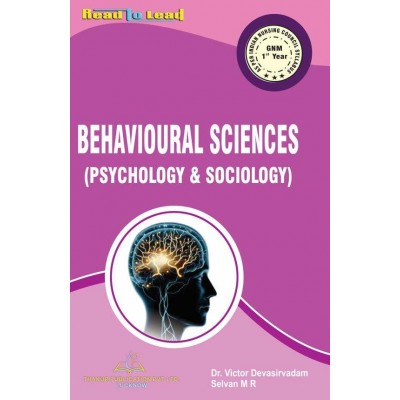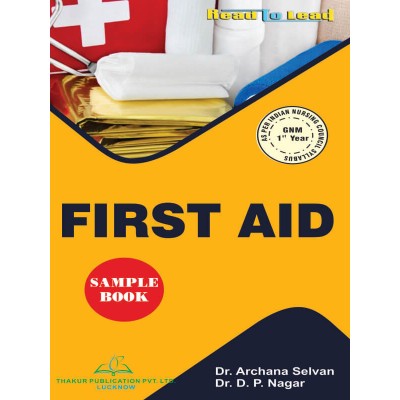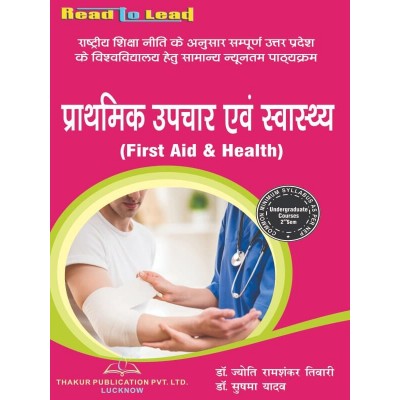Nursing foundations (Fundamentals Of Nursing And First AID) Book GNM 1st Year
₹310.00
Tax excluded
Syllabus
Nursing Foundations
(1) Fundamentals of Nursing
|
Unit |
Topics |
Hr. |
||||
|
I |
Introduction to Nursing a) Nursing – Concept, meaning, definitions, scope and functions. b) History of nursing in India c) Nursing as a profession d) Nursing professional – Qualities and preparation. e) Ethics in Nursing - Roles and responsibilities of a nurse. f) Health care agencies – Hospital and community service – Types and function of hospitals health team. g) Modern approaches to nursing care including holistic nursing care h) Health and Disease – Definition of health, determinants of health status. - Basic human needs - Illness and its effects on individual |
25 |
||||
|
II |
Nursing Care of the Patient a) Patient environment in the hospital patients unit b) Therapeutic environment - Physical factors – Lighting temperature, ventilation, humidity, noise, pestilence. - Safety needs prevention of environmental hazard - Psychosocial and aesthetic factors. c) Patient’s adjustment to the hospital. - Understanding the patient as a person socio economic and cultural background, health status, etc. - Effect of hospitalization on patient and family. - Admission, transfer, discharge procedures d) Basic nursing skills -
e) Nursing process - Meaning and importance - Assessment, planning, implementation and evaluation - Nursing care plan |
6 |
||||
|
III |
Meeting the Basic Needs of a Patient Physical Needs a) Comfort, rest, Sleep and exercise – Importance and its promotion b) Body mechanics – Moving, lifting, transferring c) Position and posture maintenance d) Comfort devices, beds and bed making – Principles of bed making, types and care of bed linen e) Safety devices, restraints and splints f) Exercises – Active and passive Hygienic Needs - Personal and environmental hygiene - Nurses role in maintaining personal and environmental hygiene. - Care of eyes, nose, ears, hands and feet. - Care of mouth, skin, hair and genitalia - Care of pressure areas, bed sores. Nutritional Needs - Diet in health and disease - Factors affecting nutrition in illness, - Nurse’s role in meeting patients nutritional needs. - Modification of diet in illness. - Diet planning and serving. - Feeding helpless patients including artificial methods of feeding. Elimination Needs - Health and sickness - Problems – Constipation, diarrhea, retention and incontinence of urine. - Nurse’s role in meeting elimination needs. - Offering bedpan and urinal – Observing and recording abnormalities. - Preparation and giving of laxative, suppositories, enemas, bowel wash, flatus tube. - Perineal care, care of patient with urinary catheter, diapers. - Maintenance of intake and output records Psychological and Spiritual Needs
Care of Terminally Ill and Dying - Dying patient’s signs and symptoms of approaching death, needs of dying patient and family, - Nursing care of dying – Special considerations; advance directives, euthanasia, will, dying declaration, organ donation etc. - Medico legal issues - Care of the dead body - Care of unit - Autopsy - Embalming - |
60 |
||||
|
IV |
Hygiene Personal Hygiene Care of skin, hair, teeth, eyes, ears hands and feet, rest and sleep, exercise, activity, recreation, posture, nutrition, elimination and menstrual hygiene Developing good health habits - Prevention and protection of disease - Maintenance of health records - Reproductive health and hygiene - Sex education and hygiene Mental Health and Hygiene - Concepts of mental health and hygiene. - Characteristics of a physically and mentally healthy person - Mental hygiene in intrauterine, infancy, childhood, and old age. |
15 |
||||
|
V |
Assessment of Patient/Client a) Physical Assessment - Importance, principles, methods of assessment - Height, weight, posture - Head to toe examination. b) Physiological Assessment - Vital signs, normal, abnormal characteristics, factors influencing the variations, - Observation and collection of specimens – Urine, stool, vomitus and sputum. c) Psychological Assessment – mood, intelligence, emotions normal and abnormal behavior. c) |
14 |
||||
|
VI |
Infection Control a) Infection control - Nature of infection - Chain of infection transmission - Defence against infection – Natural and acquired - Hospital acquired infection (nosocomial infection) b) Concept of Asepsis - Medical and surgical asepsis - Isolation precautions , barrier nursing - Hand washing – Simple, hand asepsis, surgical asepsis (scrub) - Isolation – Source and protection - Personal protective equipment – Types, uses and techniques of wearing and removing - Decontamination of unit and equipment - Transportation of infected patient - Standard safety precaution - Transmission based precautions c) Bio-medical waste management - Importance - Types of hospital wastes - Hazards associated with hospital waste - Decontamination of hospital waste - Segregation and transportation - Disposal |
20 |
||||
|
VII |
Therapeutic Nursing Care a) Care of patients with respiratory problems/dyspnea - Breathing and coughing exercises - O2 inhalation - Dry and moist inhalation - Oro nasal suctioning b) Care of patient with altered body temperature – Hot and cold applications c) Care of patients with fluid and electrolyte imbalance d) Care of unconscious patient e) Care of the bedridden patient (traction, fractures, etc.) f) Care of patient with pain g) care of patients with body elimination deviation |
30 |
||||
|
VIII |
Introduction to Clinical Pharmacology Administration of medication: General Principles/Considerations - Purposes of medication - Principles: 5 rights, special considerations, prescriptions, safety in administering medications and medication errors - Drugs forms - Routes of administration - Storage and maintenance of drugs and nurses responsibility - Broad classification of drugs - Therapeutic effect, side effect, toxic effect, allergic reaction, drug tolerance, drug interactions - Factors influencing drug actions - Systems of drug measurement: metric system, household measurements. - Converting measurements units: Conversion within one system, between systems, dosage calculations. - Terminologies and abbreviations used in prescription of medications. - Oral drug administration – oral, sublingual, buccal – equipment and procedure. - Parenteral – General principles, types of parenteral therapies. Types of syringes, needles, cannulas and infusion sets, protection from needle stick injuries, giving medications with a safety syringe. - Routes of parenteral therapies – Purposes, site equipment, procedure and special considerations in giving intradermal, subcutaneous, intramuscular and intravenous medication. - Advanced techniques: Epidural, intrathecal, intraosseous, intraperitoneal, intrapleural, intra arterial - Role of nurse - Topical administration – Purposes, site, equipment, procedure, special considerations for applications to skin and mucous membrane. Direct application – Gargle, throat swab Insertion of drug into body cavities: nasal pack, suppositories/medicated packing into rectum/vagina Instillations - Ear, eye, nasal, bladder and rectal. Irrigations: eye, ear, bladder, vaginal and rectal. Spray: nose and throat - Inhalations – Nasal, oral, endotracheal, tracheal (steam, oxygen and medications) – Purposes, types, equipment, procedure and special considerations. - Recording and reporting of medications administered. |
30 |
||||
|
(2) First Aid |
||||||
|
I |
Introduction - Definition, aims and importance of first aid - Rules/general principles of first aid - Concept of emergency |
2 |
||||
|
II |
Procedures and Techniques in First Aid - Preparation of first aid kit. - Dressing, bandaging and splinting (spiral, reverse spiral, figure of 8, spica, shoulder, hip, ankle, thumb, finger, stump, single and double eye, single and double ear, breast, jaw, capelin), triangle bandages uses, abdominal binder and bandage, breast binder, T and many tail bandage, knots reef, clove. - Transportation of the injured - CPR – Mouth to mouth, Sylvester, Schafer, External cardiac massage |
8 |
||||
|
III |
First Aid in Emergencies a) Asphyxia, drowning, shock b) Wounds and bleeding c) Injuries to the bones, joints and muscle – Fractures, sprains, strains, hanging, falls d) Burns and scalds e) Poisoning – Ingestion, inhalation, bites and stings f) Foreign body in eye, ear nose and throat. |
6 |
||||
|
IV |
Community Emergencies & Community Resources a) Fire, explosion, floods, earthquakes, famines, etc. b) Role of nurses in |
|||||
Syllabus
1.3. (1) FUNDAMENTALS OF NURSING
|
Unit |
Contents |
Hours |
|
I |
Introduction to Nursing a) Nursing – Concept, Meaning, Definitions, Scope and Functions. b) History of Nursing in India b) Nursing as a Profession c) Nursing Professional – qualities and preparation. d) Ethics in Nursing-roles and responsibilities of a nurse. e) Health care agencies – hospital and community service – types and function of hospitals health team. f) Modern approaches to nursing care including holistic nursing care g) Health and Disease - Definition of health, determinants of health status. - Basic human needs - Illness and its effects on individual |
25 |
|
II |
Nursing care of the patient a) Patient Environment in the hospital Patients unit b) Therapeutic environment - Physical factors – lighting temperature, ventilation, humidity, noise, pestilence. - Safety needs prevention of environmental hazard - Psychosocial and aesthetic factors. c) Patient’s Adjustment to the Hospital. - Understanding the patient as a person socio economic and cultural background, health status etc. - Effect of hospitalization on patient and family. - Admission, transfer, discharge procedures c) Basic Nursing Skills- - Communication - Nursing interview - Recording and reporting d) Nursing Process - Meaning and Importance - Assessment, Planning, Implementation and Evaluation - Nursing Care Plan. |
6 |
|
III |
Meeting the Basic Needs of a patient Physical needs a) Comfort, rest, Sleep and exercise. –Importanceand its promotion b) body mechanics –moving, lifting, transferring c) Position and posture maintenance d) comfort devices, Beds and bed making – Principles of bed making, types and care of bed linen e) safety devices, restraints and splints f) Exercises – Active and Passive
Hygienic needs - personal and environmental hygiene - Nurses role in maintaining personal and environmental hygiene. - Care of eyes, nose, ears, hands and feet. - Care of mouth, skin, hair and genitalia - Care of pressure areas, bed sores.
Nutritional needs - Diet in Health and disease - Factors Affecting Nutrition in illness, - Nurse’s Role in meeting Patients Nutritional needs. - Modification of diet in illness. - Diet planning and serving. - Feeding helpless patients including artificial methods of feeding.
Elimination needs - health and sickness - Problems – constipation and diarrhea, retention and incontinence of urine. - Nurse’s role in meeting elimination needs. - Offering bedpan and urinal, - Observing and Recording abnormalities. - Preparation and giving of laxative, suppositories, enemas, bowel wash, flatus tube. - Perineal care, care of patient with urinary catheter, diapers. - Maintenance of intake and output records
Psychological and spiritual needs - importance - Nurse’s role - Diversional and Recreational therapy
Care of terminally ill and dying - dying patient’s signs and symptoms of approaching death, needs of dying patient and family, - Nursing care of dying-: Special onsiderations, advance directives, euthanasia, will, dying declaration, organ donation etc. - Medico Legal Issues - Care of the dead body - Care of unit - Autopsy - Embalming |
60 |
|
IV |
Hygiene Personal Hygiene Care of skin, hair, teeth, eyes, ears, hands and feet, Rest and sleep, Exercise, Activity, recreation, posture, nutrition, elimination and menstrual hygiene Developing good health habits - Prevention and protection of disease - Maintenance of health records - Reproductive health and hygiene - Sex education and hygiene
Mental Health and hygiene - Concepts of Mental Health and Hygiene. - Characteristics of a Physically and Mentally Healthy Person - Mental Hygiene in Intrauterine, Infancy, Childhood, Adolescence, Adulthood and old age. |
15 |
|
V
|
Assessment of patient/client a) Physical Assessment - Importance, principles, methods of assessment - Height, Weight, posture - Head to toe examination. b) Physiological Assessment - Vital signs, normal, abnormal Characteristics factors influencing the variations, - Observation and collection of specimens-urine, stool, vomitus and sputum.
Psychological Assessment-Mood, Intelligence, Emotions Normal and Abnormal behavior. |
14
|
|
VI |
Infection Control a) Infection Control : - Nature of Infection - Chain of Infection Transmission - Defense Against infection : Natural and Acquired - Hospital Acquired Infection (Nosocomial Infection) b) Concept of Asepsis : - Medical and Surgical Asepsis - Isolation Precautions , Barrier Nursing - Hand Washing : Simple, Hand Asepsis, Surgical Asepsis (SCRUB) - Isolation – Source and Protection - Personal Protective Equipments –Types, uses and techniques of wearing and removing - Decontamination of unit and Equipment - Transportation of Infected Patient - Standard Safety Precaution - Transmission Based Precautions c) bio-medical waste management - Importance - Types of Hospital Wastes - Hazards Associated with hospital waste - Decontamination of Hospital waste - Segregation and Transportation - Disposal |
20
|
|
VII |
Therapeutic Nursing Care a) Care of patients with respiratory problems/dyspnea - Breathing and coughing exercises - O2 inhalation - Dry and moist inhalation - Oro nasal suctioning b) Care of patient with altered body temperature- Hot and cold Applications c) Care of patients with Fluid and Electrolyte imbalance d) Care of unconscious patient e) Care of the bedridden patient(traction, fractures etc.) f) Care of patient with pain g) care of patients with body elimination deviation |
30 |
|
VIII |
Introduction to clinical Pharmacology Administration of medication: General Principles/Considerations - Purposes of medication - Principles: 5 rights, special considerations, prescriptions, safety in administering medications and medication errors - Drugs forms - Routes of administration - Storage and maintenance of drugs and nurses responsibility - Broad classification of drugs - Therapeutic effect, side effect, toxic effect, allergic reaction, drug tolerance, drug nteractions - Factors influencing drug actions - Systems of drug measurement: metric system, household measurements. - Converting measurements units: conversion within one system, between systems, dosage calculations. - Terminologies and abbreviations used in prescription of medications. - Oral drug administration: oral, sublingual, buccal equipment and procedure. - Parentral : General Principles Types of Parentral Therapies. Types of Syringes, Needles, Canulas and Infusion Sets, Protection from needle stick injuries, giving medications with a safety syringe. - Routes of parentral therapies: Purposes, site equipment, procedure and special considerations in giving intradermal, subcutaneous, intramuscular and intravenous medications. - Advanced techniques : epidural, intrathecal, intraosseous, intraperitoneal, intrapleural, intra arterial - Role of nurse - Topical administration: purposes, site, equipment, procedure, special considerations for applications to skin and mucous membrane. Direct application: gargle, throat swab Insertion of drug into body cavities: nasal pack, suppositories / medicated packing into rectum / vagina Instillations: ear, eye, nasal, bladder and rectal. Irrigations: eye, ear, bladder, vaginal and rectal. Spray: nose and throat - Inhalations: nasal, oral, endotracheal, tracheal (steam, oxygen and medications) – purposes, types, equipment, procedure and special considerations. - Recording and reporting of medications administered. |
30 |
1.3. (2) FIRST AID
|
Unit |
Contents |
Hours |
|
I |
Introduction - Definition, Aims and Importance of first aid - Rules/ General principles of First Aid - Concept of emergency |
2 |
|
II |
Procedures and Techniques in First Aid - Preparation of First Aid kit. - Dressing, Bandaging and Splinting(Spiral, Reverse Spiral, Figure of 8 Spica, Shoulder, Hip, Ankle, Thumb, Finger, Stump, Single and Double Eye, Single and Double Ear, Breast, Jaw, Capelin), Triangle Bandages Uses, Abdominal Binder and Bandage, Breast Binder, T and many tail Bandage, Knots Reef, Clove. - Transportation of the injured - CPR: Mouth to mouth, Sylvester, Schafer, External cardiac massage |
8 |
|
III |
First Aid in emergencies a) Asphyxia, Drowning, shock b) Wounds and Bleeding c) Injuries to the Bones, Joints and Muscle- Fractures, Sprains, Strains, Hanging, Falls d) Burns and Scalds e) Poisoning – Ingestion, Inhalation, bites and stings <span lang="en- |
INC2025/GNM(english)/1/03
36 Items
New
5 other products in the same category:
Comments (0)
No customer reviews for the moment.




















